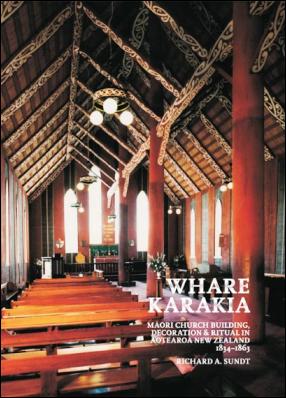History Of Early Maori Anglican Churches Launched
First History Of Early Maori Anglican Churches Launched This Week
Dr Richard A Sundt, of the University of Oregon is in New Zealand this month to give several lectures and launch his new book on early Maori Anglican churches, Whare Karakia: Māori Church Building Decoration and Ritual in Aotearoa New Zealand 1834–1863, published by Auckland University Press.
Whare Karakia, the first book to chronicle this early phase of Māori church building, sheds new light on the history of religion, architecture and the story of Māori and Pākehā in New Zealand.
“The genesis of this book dates back to 1997 when I first visited New Zealand to teach a course on Oceanic art at Victoria University of Wellington,” says Dr Sundt.
“Shortly after my arrival, I learned about the Māori church of Rangiātea at Ōtaki, which had burned down two years earlier. I was struck immediately by the similarities between Ōtaki and many of the Gothic churches of the 13th and 14th centuries in Europe that I had researched as a specialist in mediaeval architectural history (Pacific Islands art and architecture is one of my sub-specialities). After some preliminary investigations, I realised that Māori whare-style churches, like Ōtaki, were quite common in 19th-century Aotearoa New Zealand, even though a design employing posts down the central axis might not have been the first preference of the English missionary establishment.”
After the arrival of Anglican missionaries in the 19th century, Māori were slowly converted to Christianity and built many of the early churches, developing a distinctive and arresting new style that combined British ecclesiastical tradition with elements from Māori art and architecture. The whare scheme initially challenged Western architectural presumptions around the use of ritual space but was later accepted by the Anglican establishment as a convenient model for its missions.
Over many years, and in the course of four subsequent visits to New Zealand, Dr Sundt has researched the whare structure, the changes in building technology, and the way sacred space was handled in Māori buildings in order to accommodate the peculiarities of the Anglican ritual, producing several articles and now his new book Whare Karakia.
Dr
Sundt will be visiting Auckland, Gisborne, Wellington,
Otaki, New Plymouth, Te Kuiti and Te Awamutu on his trip.
His public talks on the whare karakia will include:
15
July Auckland, 5.30–7pm: book launch, Parsons Bookshop,
Wellesley St, City
18 July Manutūkē, 2–4pm
19
July Gisborne, 5.30pm: lecture, Tairāwhiti Museum
23
JulyWellington, 12–1pm: lecture, Beaglehole Room (where he
first started his research into the whare karakia), Victoria
University of Wellington

About the Author Dr Richard A Sundt is Associate Professor in art history at the University of Oregon where he has taught for 25 years. He teaches on Greek and Roman Architecture and Romanesque and Gothic Architecture as well as Pacific Art. He has published extensively on gothic architecture – in particular on the Dominican church at Toulouse and on Dominican legislation on art and architecture in the 13th century. Dr Sundt is a member of many professional societies including the Archaeological Institute of America, the Association Villard de Honnecourt (AVISTA), the College Art Association, the International Center of Medieval Art, the Medieval Academy of America, the Pacific Art Association (for Oceanic art), the Société Française d’Archéologie, the Society for Medieval Feminist Scholarship and the Society of Architectural Historians.

Whare Karakia: Māori Church Building, Decoration and Ritual in Aotearoa New Zealand by Richard A Sundt Published by Auckland University Press Hardback; photographs, plans, drawings; RRP $69.99
ENDS


 International Writers' Workshop NZ Inc: Ōtepoti Poets Top The Kathleen Grattan Prize For A Sequence Of Poems
International Writers' Workshop NZ Inc: Ōtepoti Poets Top The Kathleen Grattan Prize For A Sequence Of Poems NZ Amateur Sport Association: 22 Amendments Proposed For 2022 Act Lodged On 22 November
NZ Amateur Sport Association: 22 Amendments Proposed For 2022 Act Lodged On 22 November Auckland University of Technology: Reading Helps Children Face A Difficult Future
Auckland University of Technology: Reading Helps Children Face A Difficult Future PATHA: Puberty Blocker Evidence Brief Affirms Aotearoa’s Approach
PATHA: Puberty Blocker Evidence Brief Affirms Aotearoa’s Approach Tataki Auckland Unlimited: Into Ocean & Ice - Unveiling Antarctica's Past And Present
Tataki Auckland Unlimited: Into Ocean & Ice - Unveiling Antarctica's Past And Present Health Coalition Aotearoa: Urgent Action Needed To Address Aotearoa’s Shameful Household Food Insecurity
Health Coalition Aotearoa: Urgent Action Needed To Address Aotearoa’s Shameful Household Food Insecurity